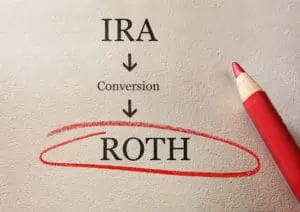These days, I find there’s no shortage of opinions and advice about the best way to save for retirement. The use of social media and other online platforms give anyone and everyone the ability to weigh in with their 2 cents. But who can you believe, especially when it comes to something as crucial as saving for a lifetime without a paycheck?
Unfortunately, I run across too many poorly-reasoned arguments for or against certain investment strategies or retirement savings vehicles. For example, this past week a client shared an article about Roth IRAs with me, that he found on-line. The author of the article clearly had a strong bias against Roth IRAs and insisted that no one should ever use one and should instead use a traditional IRA to enjoy the current tax benefits it offers. Now, I absolutely believe that there is no one-size-fits-all solution for everyone. What makes sense for your financial profile may not work for your neighbor’s financial profile. Therefore, it bothers me when I see someone take such an absolute position on any investment strategy or investment vehicle.
A Roth IRA, with its potential for tax-free growth and tax-free withdrawals, might be a good option for you. But to really know for sure, you need to understand how it works to determine if it makes sense for your unique situation.
First, let’s talk about the basics.
Roth IRAs and traditional IRAs are both tax-advantaged retirement accounts, but they differ in distinct ways.
Traditional IRA contributions are tax-deductible at the federal tax level , assuming you meet certain guidelines, and are also tax-deductible in some states. Contributions are no longer permitted for the year you reach age 70 ½ and after, and distributions are taxed as ordinary income. Traditional IRAs are subject to mandatory distributions, starting with the year you reach age 70-½.
Roth IRA contributions are made using after-tax dollars, and there is no age cap on Roth IRA contributions. But you are ineligible to make Roth IRA contributions if your income is too high. Distributions from Roth IRAs are nontaxable, as long as you have funded a Roth IRA for at least five years and you are age 59 ½ or older at the time of the distribution. If you do not meet these two requirements, then any portion of your distributions attributed to earnings would be taxable. Also unlike traditional IRAs, there are no mandatory distributions required during your lifetime, which means you can maintain a Roth IRA pretty much indefinitely.
Next, what type of investments can we use in a Roth?
If you’re looking for more direct control over your retirement investments than you have in your employer-sponsored 401(k) program, IRAs may provide an excellent choice. The ICI Research Perspective recently conducted a survey to help us better understand how the average investor uses their Roth IRA. Here are some of the more common investments found inside the Roth IRA, according to the study.
Far and away, the most popular asset class found in the average investor’s Roth IRA is the mutual fund. Little surprise there – mutual funds are a mainstay of retirement investment accounts. They can be easily understood, and may provide the opportunity for diversification, and comparatively low transactional costs. In fact, 71% of those polled by the ICI have assets in mutual funds, with 49% of them investing in equity funds and 24% of those polled held bond funds. Actively-managed funds, which often involve frequent trading, may also be well-suited for Roth IRAs since earnings grow tax-free; therefore, you won’t pay capital gains taxes on trades.
Many Roth IRA investors polled by the ICI also invest in individual stocks – about 40%, making it the second most common type of investment for Roth IRAs. Income-oriented stocks are well-suited to Roth IRAs – stocks with high dividends or preferred shares, for example. If you find yourself trading equities frequently, the capital gains tax shelter offered by Roth IRAs can make them an attractive choice.
Bonds are another popular asset class for the average Roth IRA investor, with 24% of accounts containing individual bonds. Corporate bonds and other high-yield debt can be ideal for Roth IRAs, thanks to the Roth’s tax protection. Bond dividend payments typically yield more significant taxable gains than growth stocks, but you avoid paying tax on bond dividends held in a Roth IRA account.
23% of those polled also keep Roth IRA investments in Exchange-Traded Funds (ETFs). ETFs tend to be passively-managed. ETFs are a popular investment vehicle because of their diversification, good yield potential, and lower expense ratios than mutual funds.
In general, the tax sheltering characteristics of the Roth IRA makes it well-suited for investments that tend to generate high taxable income either through dividends or interest. Roth IRAs may also be appropriate for high-growth investments, and investments that might generate short-term capital gains through high turnover. The tax benefits of the Roth IRA might also be a good option for you believe your tax bracket will be higher during retirement.
Finally, who can own a Roth IRA?
You can make annual contributions of up to 100 percent of your eligible compensation to a Roth IRA, up to $6,000, plus up to $1,000 in catch-up contribution if you are age 50 or older by the end of the year. If your income is over the limit, preventing you from making a Regular Roth IRA contribution, you still may be able to fund one by converting existing money from a traditional IRA or other eligible retirement savings account. The Modified Adjusted Gross Income (MAGI) cap for regular Roth IRA contributions is $137,000 for individuals who file as single, $203,000 for married couples filing jointly, and $10,000 for married couples filing separately.
Roth IRAs should be considered retirement savings vehicles and treated like such, but if there is an emergency that requires you to withdraw your retirement savings, Roth IRAs offer some flexibility. As you have already paid tax on your Roth IRA contributions, you may withdraw those amounts at any time without paying taxes or early distribution penalties. In cases where your distribution might be subject to an early distribution penalty – such as the early withdrawal of earnings in a nonqualified distribution, an exception to the penalty applies in some cases- such as if the funds are used for qualified higher-education expenses, or towards the purchase of a first home ( subject to a lifetime limit of $10,000).
Folks, whether or not a Roth IRA makes sense for you will depend entirely on your individual goals, your appetite for risk, your time horizon for retirement, and other factors. In many cases, a Roth IRA is the right choice. But as always, it’s crucial to work with a trusted financial professional to make sure you’re making the most appropriate decisions for your long-term retirement savings goals.
Be vigilant and stay alert, because you deserve more.
Have a great week!
Jeff Cutter, CPA/PFS is President of Cutter Financial Group, LLC, a wealth management firm with offices in Falmouth, Duxbury, and Mansfield. Jeff can be reached at jeff@cutterfinancialgroup.com.
Cutter Financial Group LLC (“Cutter Financial”) is a SEC Registered Investment Advisor.
This article is intended to provide general information. It is not intended to offer or deliver investment advice in any way. Information regarding investment services is provided solely to gain a better understanding of the subject or the article. Different types of investments involve varying degrees of risk. Therefore, it should not be assumed that future performance of any specific investment or investment strategy will be profitable.
Market data and other cited or linked-to content in this article is based on generally-available information and is believed to be reliable. Cutter Financial does not guarantee the performance of any investment or the accuracy of the information contained in this article. Cutter Financial will provide all prospective clients with a copy of Cutter Financials Form ADV2A and applicable Form ADV 2Bs. Please contact us to request a free copy via .pdf or hardcopy.





